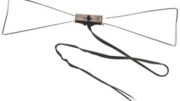Have you considered stacking your antennas? Stacking two antennas together allows you to get more signal and that can really help with reception if you’re far away from the towers. It’s also a way to get signals from two different directions. For example, if you’re halfway between Milwaukee and Chicago, you can stack two antennas and get both sets of stations. But, there are some things you should consider when looking at stacking as a way to get the channels you want.
First, the honest fact
Stacking antennas isn’t a perfect solution for everyone. Stacking two identical antennas together and pointing them at the same direction will bring you about 2.5dB more signal. You can easily get this same amount of increase from even the least expensive antenna amplifier. Stacking will generally give you less noise than amplifying though, which could make the difference in some marginal signals.
You’ll have a lot more success when stacking antennas to get signals in different directions. You will want to use a decent long-range antenna like our HDB91X or HD8200XL for best results of course. With setups like these, people have reported reception of distant signals 75-90 miles apart when you’ve done it correctly.
Let’s talk stacking distance
You’ll get a lot of opinions when you ask someone how far apart two antennas should be when stacking. Certainly if they are too close they are going to interfere with each other.
The most accurate number I’ve heard is “no closer than half the wavelength of the lowest channel either antenna will pick up.” That means that for a VHF antenna they should be 6 feet from each other, and with a UHF antenna at least 2.5 feet. The distance is the distance between the actual elements and not counting reflectors Generally, the angled bits at the back of an antenna like what you see above.
If you’re using a UHF antenna, it should be easy to stack those antennas. But yes, with a UHF/VHF antenna, you could end up with a very tall mast. If that’s the case, make sure you’re securing it properly. Use a chimney mount or guy wires to make sure that the whole thing will stand up to the wind it’s likely to encounter. You can find these things when you shop at Solid Signal.
In the real world
However, these are guidelines. Everything I’ve written above is subject to how it works for you. Every situation is different. There is one thing to consider, though. You should definitely follow the “at least” part of the distance recommendations. What you’re trying to do here is avoid interference, and while these are good guidelines, they don’t always apply 100% to your situation. If you stack two antennas together and find that you’re getting weird interference or poor performance, separate them. Simple as that.
If you’d like to talk to a real antenna professional with experience in the field, call us during East Coast business hours! The number is 888-233-7563 and we’ll be happy to help you out!





